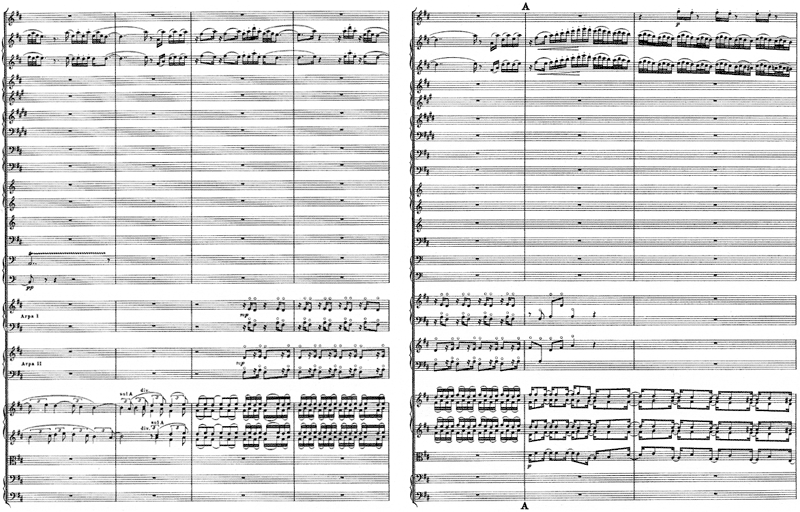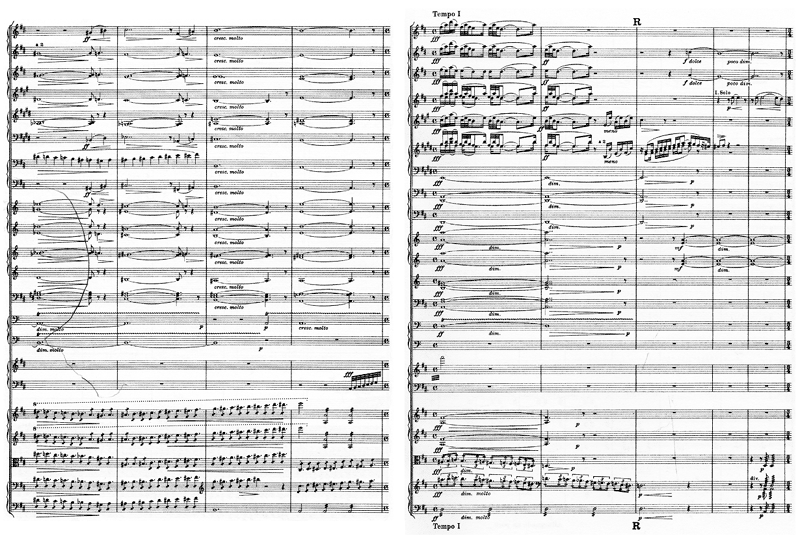Op. 73 Aallottaret (The Oceanides), symphonic poem.
Version 1, 1913 (?).
First movement of 1st version missing. First public performance of the 2nd and 3rd movements in Lahti
19th and 20th September 2002.
2nd version in 1914; first performance in Lahti 24th October 2002 (Lahti Symphony Orchestra under Osmo Vänskä).
Version 2 (in D flat major), April 1914. First performance in Lahti, 24th
October 2002 (Lahti Symphony Orchestra under Osmo Vänskä). Final
version (in D major), May 1914. First performance in Norfolk
(USA), 4th June 1914 (conducted by Jean Sibelius).
The Oceanides ("sea nymphs"; in Finnish Aallottaret or "nymphs of the waves") was written for the Norfolk Music Festival in the United States. It resulted from a commission by Horatio Parker, who was acting on the authorisation of the millionaire and festival promoter Carl Stoeckel and his wife. In 1913 Sibelius started to prepare the work, initially as a suite in three movements. The first movement of the suite has not survived but the second and third movements were performed for the first time as unexpected encores in the autumn of 2002, at the Lahti Sibelius festival under Osmo Vänskä.
The movements are sketchy and their orchestration may be incomplete. The thematic material of The Oceanides is clearly recognisable in the third movement. The second movement is more heterogeneous, and material from it ended up in other compositions. Sibelius wrote on the sketches: "Fragments of a suite for orchestra (Precursor to 'The Oceanides')". Nevertheless, the sketch-like movements are good and interesting music in their own right.
In the spring of 1914 Sibelius prepared a one-movement orchestral work in D flat major from the material. He sent it to the United States on 3rd April. Sibelius considered giving the composition a German title, but in a copyist's receipt from 3rd April the name is already Aallottaret (The Oceanides). Along with the score Sibelius sent a brief explanation in German of what Aallottaret means in Finnish mythology.
Only a few days later Sibelius was asked, if he could come to the United States and conduct the work. He answered in the affirmative. At the same time, he decided to revise the composition, as we know from Aino Sibelius's diary. She writes as follows:
"I am very nervous about that journey, although I see how Janne can benefit from it. And it may be such fun! Janne is rewriting the whole American composition, Aallottaret, as it is called at least for the time being. It is so exhausting for me, but I understand him.Today we have been thinking of adding to the programme for America. Half of the concert programme falls to Janne."
In May the composition temporarily had a German name once again. Aino Sibelius describes the feverish process of copying the music:
"(14th May) The journey to America is approaching. Rondeau der Wellen is not yet completed. Feverish hurry. The journey has been scheduled for Saturday. The score is still unfinished. The copyist, Mr. Kauppi, lives with us and writes day and night. Yesterday we learnt that he has to leave already on Friday evening. It's indescribable. It was a question of using every last hour. Besides, the whole practical side is completely unprepared. This can work only with Janne's energy. Otherwise the journey would be completely out of question. (…)
"Yesterday evening we couldn't accomplish anything practical anymore, but then Janne forced himself to work with his great strength. There are still about twenty pages missing. We lit the lamps in the dining-room, the chandelier in the drawing room, it was a solemn moment. I did not dare to say anything. I just tried to create a pleasant environment. Then I went to bed and Janne stayed awake. All night long I kept hearing his steps, sometimes quiet playing. Towards morning he had moved upstairs. The copyist was awake in his own chamber. It is morning now. The tension continues, there are many things to be done today. If I just could stay very calm, it is the only way in which I can now be of any use."
Sibelius was able to take the new score in D major with him on the journey. He made a few corrections to it, inspired by the sea voyage. But why was it necessary to change the fully prepared D flat major version into a version in D major? The composer Kalevi Aho believes that the reasons were connected with the practicalities of performance and technique:
"In D flat major the string players can hardly use any open strings at all, and because the work is very swift-moving in places, it is very difficult for the strings, both technically and in terms of getting a clear tone. In contrast, D major is a very rewarding key for the violins because you can always use open strings in the swift figures. On the other hand, the orchestral tone in D flat major is veiled, somehow mysterious and impressionistic. Compared with it D major sounds clearer, but also more matter-of-fact. Maybe Sibelius was afraid of the reaction of the musicians to technically difficult music in D flat major and that was why he changed the key and rewrote the work once again. I don't think that purely musical weaknesses would have required a new version in this case."
In Aho's opinion the change of key and the simplification of a few details made the work easier to perform, but at the same time the composition lost "something essential" as regards the sound quality.
In the United States Sibelius realised at the rehearsals that the work was demanding enough for the musicians even in D major. According to Carl Stoeckel The Oceanides was very different from anything the musicians had played previously.
Nevertheless, the concert was a splendid success. Indeed, the audience wept with emotion during Finlandia and Valse triste. The critics, too, were exultant and the composer himself was enthusiastic:
"Up till now I have never (...) conducted another orchestra made up of so many skilful musicians as that orchestra of a hundred players that Mr. Stoeckel got together from Boston and from the New York Metropolitan Opera. For example, in The Oceanides I achieved a build-up that, to a very great degree, surprised even myself.
In The Oceanides Sibelius utilises Debussy's impressionist tone world. It should be remembered, however, that this aspect had already become apparent in the musical language of Sibelius, in such early orchestral works as Kullervo and Lemminkäinen in Tuonela.
The Oceanides starts with an entirely different atmosphere. In the introduction a new day seems to be dawning at sea. The flutes are glimmering like the sun above the surge of the strings. It is not easy to find a clear main theme. An entire thematic group grows from the fragmentary phrases of the flutes, whose materials undergo a continuous metamorphosis.

Excerpt from the score of The Oceanides.
Breitkopf & Härtel.
The second thematic group begins to develop from the melodies of the oboe and the cor anglais. From the gleaming of the surface we move to deeper waters.

Excerpt from the score of The Oceanides.
Breitkopf & Härtel.
Both thematic groups alternate but remain continuously interdependent. During the development the storm develops slowly and the waves rise higher and higher. Finally we experience the "crash of the great wave", as Olin Downes has described the climax.

Excerpt from the score of The Oceanides.
Breitkopf & Härtel.
The waves calm down in the final beats of the work. Thus Sibelius has completed a transitional work which is the culmination of his particular kind of impressionism. From this he will turn outwards with greater force after completing such introvert masterpieces as the fourth symphony, The Bard and Daughter of Nature.
The next great challenges would be symphonies 5-7. Only a year after the completion of The Oceanides Sibelius was working on sketch material for all these works at the same time.

